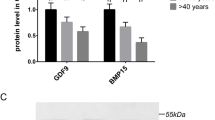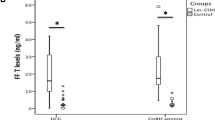Abstract
Purpose
To identify expression of Notch signaling proteins and its ligands in human cumulus cells which were obtained by follicle aspiration and to compare the differences of this protein expression between the normal and poor responder patients.
Methods
47 patients who applied to the assisted reproductive treatments with various infertility problems were included to the study. Controlled ovarian hyperstimulation was performed by using GnRH agonist and gonadotropins. Serum hormon levels were measured by using Chemilluminescent Microparticle Immunoassay method for each patient. After ultrasonographic ovarian follicle screening, oocytes were retrievaled. Cumulus cells obtained from the follicles were cultured for 72 h and immunuhistochemistry were performed for Notch1, Notch2, Notch3, Notch4, Jagged1 and Jagged2 proteins. Histological score (HSCORE) were applied to all of the samples. The association between Notch and its ligands protein expressions and the oocyte-embryo quality and fertilization rates were investigated.
Results
Significant differences were observed between the mean values of age, AMH and FSH in the 2 groups, respectively (p < 0.05). However, the mean female infertility duration and total gonadotropin dose did not differ significantly between normal and poor responder groups. All the patients cumulus cells expressed Notch1, Notch2, Notch3, Notch4, Jagged1 and Jagged2. There was a significant difference (p < 0.05) only for Notch2 between the 2 groups and a positive correlation between Notch2 and Notch3 (r = 547, p = 0.00) expressions were noted. Furthermore, no correlations were observed between the following: Notch1, Notch2, Notch3, Notch4, Jagged1, and Jagged2 expression; mature oocyte number; fertilization rates, and embryo quality percentage in both of the groups.
Conclusion
Notch signalling proteins can be an indicator for understanding the ovarian response in ovulation induction.




Similar content being viewed by others
References
Johnson J, Espinoza T, McGaughey RW, Rawls A, Wilson-Rawls J. Notch pathway genes are expressed in mammalian ovarian follicles. Mech Dev. 2001;109(2):355–61.
Knight PG, Glister C. TGF-beta superfamily members and ovarian follicle development. Reproduction. 2006;132:191–206.
Russell DL, Robker RL. Molecular mechanisms of ovulation: co-ordination through the cumulus complex. Hum Reprod Updat. 2007;13:289–312.
Uyar A, Torrealday S, Seli E. Cumulus and granulosa cell markers of oocyte and embryo quality. Fertil Steril. 2013;99(4):979–97.
Teilmann SC. Differential expression and localisation of connexin-37 and connexin-43 in follicles of different stages in the 4-week-old mouse ovary. MolCell Endocrinol. 2005;234:27–35.
Trombly DJ, Woodruff TK, Mayo KE. Suppression of Notch signaling in the neonatal mouse ovary decreases primordial follicle formation. Endocrinology. 2009;150:1014–24.
Wang Z, Li Y, Banerjee S, Sarkar FH. Exploitation of the Notch signaling pathway as a novel target for cancer therapy. Anticancer Res. 2008;28:3621–30.
Cepni I, Kahraman N, Ocal P, Idil M, Uludag S. Expression and comparison of gap junction protein connexin 37 in granulosa cells aspirates from follicles of poor responder and nonpoor responder patients. Fertil Steril. 2008;89:417–20.
Veeck LL. Oocyte assesment and biological performance. Ann N Y Acad Sci. 1999;541:259–74.
Ocal P, Ersoylu B, Cepni I, Guralp O, Atakul N, Irez T, et al. The association between homocysteine in the follicular fluid with embryo quality and pregnancy rate in assisted reproductive techniques. J Assist Reprod Genet. 2012;29:299–304.
Idil M, Cepni I, Demirsoy G, Ocal P, Salihoğlu F, Senol H, et al. Does granulosa cell apoptosis have a role in the etiology of unexplained infertility? Eur J Obstet Gynecol Reprod Biol. 2004;112:182–4.
Jancar N, Kopitar AN, Ihan A, Virant Klun I, Bokal EV. Effect of apoptosis and reactive oxygen species production in human granulosa cells on oocyte fertilization and blastocyst development. J Assist Reprod Genet. 2007;24:91–7.
Tingen C, Kim A, Woodruff TK. The primordial pool of follicles and nest breakdown in mammalian ovaries. Mol Hum Reprod. 2009;15:795–803.
Otsuka F, McTavish KJ, Shimasaki S. Integral role of GDF-9 and BMP-15 in ovarian function. Mol Reprod Dev. 2011;78(1):9–21. doi:10.1002/mrd.21265. Epub 2011 Jan 11. PubMed PMID: 21226076; PubMed Central PMCID: PMC3051839.
Edson MA, Nalam RL, Clementi C, Franco HL, Demayo FJ, Lyons KM, et al. Granulosa cell-expressed BMPR1A and BMPR1B have unique functions in regulating fertility but act redundantly to suppress ovarian tumor development. Mol Endocrinol. 2010;24:1251–66.
Vorontchikhina MA, Zimmermann RC, Shawber CJ, Tang H, Kitajewski J. Unique patterns of Notch1, Notch4 and Jagged1 expression in ovarian vessels during folliculogenesis and corpus luteum formation. Gene Expr Patterns. 2005;5:701–9.
Jiang R, Lan Y, Chapman HD, Shawber C, Norton CR, Serreze DV, et al. Defects in limb, craniofacial, and thymic development in Jagged2 mutant mice. Genes Dev. 1998;12:1046–57.
Krebs LT, Xue Y, Norton CR, Sundberg JP, Beatus P, Lendahl U, et al. Characterization of Notch3-deficient mice: normal embryonic development and absence of genetic interactions with a Notch1 mutation. Genesis. 2003;37(3):139–43. PubMed PMID: 14595837.
Krebs LT, Xue Y, Norton CR, Shutter JR, Maguire M, Sundberg JP, et al. Notch signaling is essential for vascular morphogenesis in mice. Genes Dev. 2000;14:1343–52.
Guo S, Liu M, Gonzalez-Perez RR. Role of Notch and its oncogenic signaling crosstalk in breast cancer. Biochim Biophys Acta. 1815;2011:197–213.
Feyles V, Gianetto-Berruti A. Poor responders in assisted reproduction cycles. Minerva Ginecol. 2005;57:1–14.
Pellicer A, Ardiles G, Neuspiller F, Remohi J, Simon C, Bonilla-Musoles F. Evaluation of the ovarian reserve in young low responders with normal basallevels of follicle-stimulating hormone using three-dimensional ultrasonography. Fertil Steril. 1998;70(4):671–5.
Faber BM, Mayer J, Cox B, Jones D, Toner JP, Oehninger S, et al. Cessation of gonadotropin-releasing hormone agonist therapy combined with high-dose gonadotropin stimulation yields favorable pregnancy results in low responders. Fertil Steril. 1998;69(5):826–30.
Karande V, Gleicher N. A rational approach to the management of low responders in in-vitro fertilization. Hum Reprod. 1999;14:1744–8.
Vollenhoven B, Osianlis T, Catt J. Is there an ideal stimulation regimen for IVF for poor responders and does it change with age? J Assist Reprod Genet. 2008;25:523–9.
Seifer DB, Gardiner AC, Ferreira KA, Peluso JJ. Apoptosis as a function of ovarian reserve in women undergoing in vitro fertilization. Fertil Steril. 1996;66:593–8.
Xue Y, Gao X, Lindsell CE, Norton CR, Chang B, Hicks C, et al. Embryonic lethality and vascular defects in mice lacking the Notch ligand Jagged1. Hum Mol Genet. 1999;8(5):723–30.
Hamada Y, Kadokawa Y, Okabe M, Ikawa M, Coleman JR, Tsujimoto Y. Mutation in ankyrin repeats of the mouse Notch2 gene induces early embryonic lethality. Development. 1999;126(15):3415–24.
Jovanovic VP, Sauer CM, Shawber CJ, Gomez R, Wang X, Sauer MV, et al. Intraovarian regulation of gonadotropin-dependent folliculogenesis depends on notch receptor signaling pathways not involving Delta-like ligand 4 (Dll4). Reprod Biol Endocrinol. 2013;11:43.
Visser JA, de Jong FH, Laven JS, Themmen AP. Anti-Müllerian hormone: a new marker for ovarian function. Reproduction. 2006;131(1):1–9.
Choi MH, Yoo JH, Kim HO, Cha SH, Park CW, Yang KM, et al. Serum anti-Müllerian hormone levels as a predictor of the ovarian response and IVF outcomes. Clin Exp Reprod Med. 2011;38:153–8.
Acknowledgments
The present study was supported by the Research Fund of Istanbul University (project no: 3588). The authors thank Fatih Tanriverdi for the technical assistance.
Conflict of interest
The authors state that they do not have any potential conflict of interest that would compromise the validity of the research conducted.
Author information
Authors and Affiliations
Corresponding author
Additional information
This study was approved by the Etics Committe and Institutional Board of the Cerrahpasa School of Medicine (institutional review board number: 27568).
The present work was supported by the Research Fund of Istanbul University
Project No: 3588.
Capsule
Our data indicates Notch and its ligands are expressed in cumulus cells of follicle in human ovary and Notch signalling proteins can be an indicator for understanding the ovary response.
Rights and permissions
About this article
Cite this article
Tanriverdi, G., Denir, S., Ayla, S. et al. Notch signaling pathway in cumulus cells can be a novel marker to identify poor and normal responder IVF patients. J Assist Reprod Genet 30, 1319–1326 (2013). https://doi.org/10.1007/s10815-013-0072-4
Received:
Accepted:
Published:
Issue Date:
DOI: https://doi.org/10.1007/s10815-013-0072-4




